L3 Study Skills Assignment: Text Analysis and Evaluation
VerifiedAdded on 2022/12/26
|22
|10199
|22
Homework Assignment
AI Summary
This assignment analyzes three texts related to nursing, focusing on understanding different text types, audiences, purposes, and styles. The student completes a table for each text, detailing genre, audience, subject, purpose, context, attitudes, values, and an evaluation of the writer's effectiveness. The first text, by A. Bly (1887), is a narrative describing the author's experience in a mental asylum. The analysis identifies the narrative genre, the intended audience as the general public, and the purpose of educating readers about poor conditions in asylums. The text highlights social and cultural contexts, including the lack of compassion and scientific rigor in patient care. The student evaluates the author's use of narrative style as effective in conveying the message. The assignment demonstrates the student's ability to analyze texts, identify key elements, and evaluate the effectiveness of writing styles within a specified academic framework.
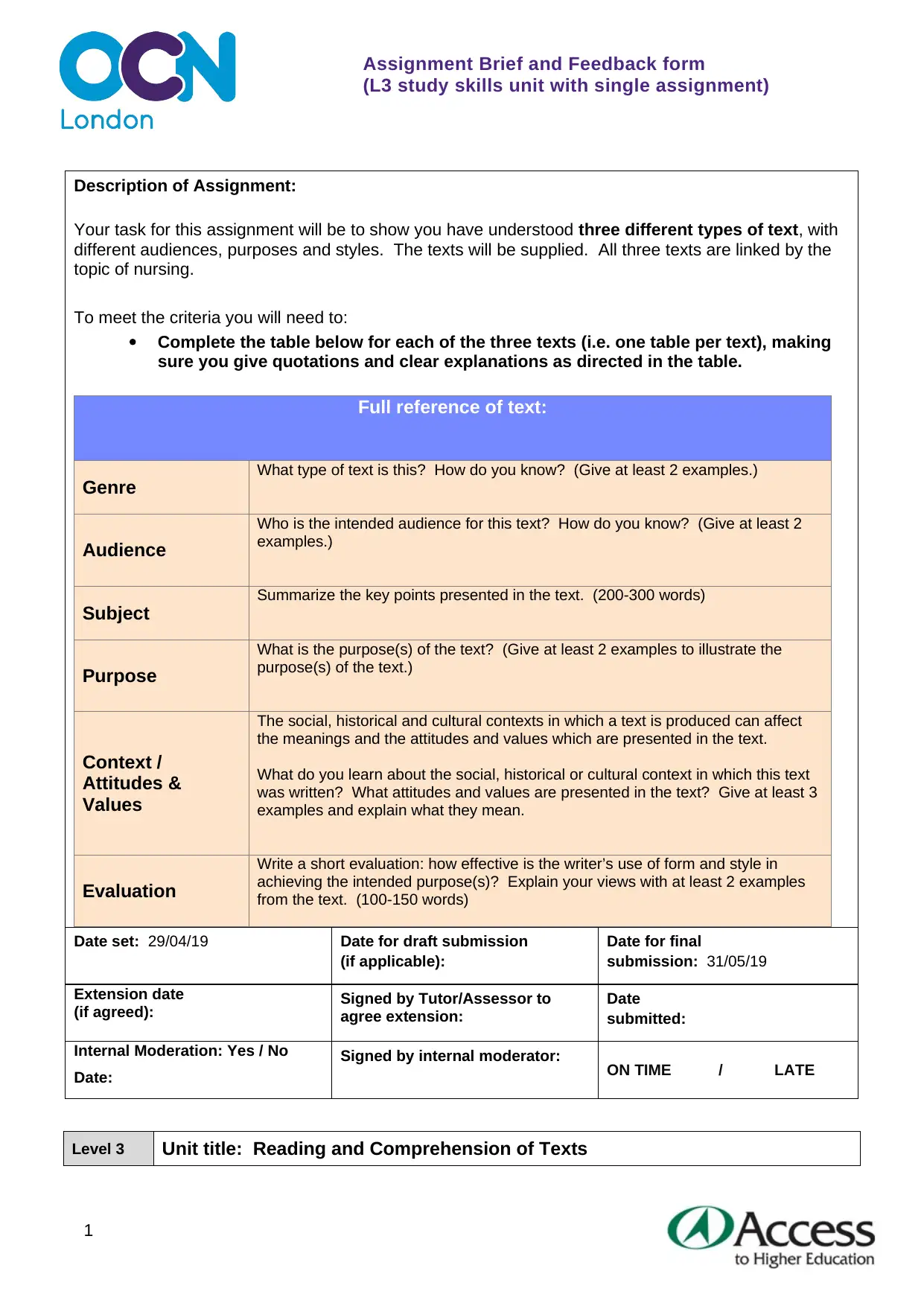
Assignment Brief and Feedback form
(L3 study skills unit with single assignment)
“”
Description of Assignment:
Your task for this assignment will be to show you have understood three different types of text, with
different audiences, purposes and styles. The texts will be supplied. All three texts are linked by the
topic of nursing.
To meet the criteria you will need to:
Complete the table below for each of the three texts (i.e. one table per text), making
sure you give quotations and clear explanations as directed in the table.
Full reference of text:
Genre
What type of text is this? How do you know? (Give at least 2 examples.)
Audience
Who is the intended audience for this text? How do you know? (Give at least 2
examples.)
Subject
Summarize the key points presented in the text. (200-300 words)
Purpose
What is the purpose(s) of the text? (Give at least 2 examples to illustrate the
purpose(s) of the text.)
Context /
Attitudes &
Values
The social, historical and cultural contexts in which a text is produced can affect
the meanings and the attitudes and values which are presented in the text.
What do you learn about the social, historical or cultural context in which this text
was written? What attitudes and values are presented in the text? Give at least 3
examples and explain what they mean.
Evaluation
Write a short evaluation: how effective is the writer’s use of form and style in
achieving the intended purpose(s)? Explain your views with at least 2 examples
from the text. (100-150 words)
Date set: 29/04/19 Date for draft submission
(if applicable):
Date for final
submission: 31/05/19
Extension date
(if agreed): Signed by Tutor/Assessor to
agree extension:
Date
submitted:
Internal Moderation: Yes / No
Date:
Signed by internal moderator: ON TIME / LATE
Level 3 Unit title: Reading and Comprehension of Texts
1
(L3 study skills unit with single assignment)
“”
Description of Assignment:
Your task for this assignment will be to show you have understood three different types of text, with
different audiences, purposes and styles. The texts will be supplied. All three texts are linked by the
topic of nursing.
To meet the criteria you will need to:
Complete the table below for each of the three texts (i.e. one table per text), making
sure you give quotations and clear explanations as directed in the table.
Full reference of text:
Genre
What type of text is this? How do you know? (Give at least 2 examples.)
Audience
Who is the intended audience for this text? How do you know? (Give at least 2
examples.)
Subject
Summarize the key points presented in the text. (200-300 words)
Purpose
What is the purpose(s) of the text? (Give at least 2 examples to illustrate the
purpose(s) of the text.)
Context /
Attitudes &
Values
The social, historical and cultural contexts in which a text is produced can affect
the meanings and the attitudes and values which are presented in the text.
What do you learn about the social, historical or cultural context in which this text
was written? What attitudes and values are presented in the text? Give at least 3
examples and explain what they mean.
Evaluation
Write a short evaluation: how effective is the writer’s use of form and style in
achieving the intended purpose(s)? Explain your views with at least 2 examples
from the text. (100-150 words)
Date set: 29/04/19 Date for draft submission
(if applicable):
Date for final
submission: 31/05/19
Extension date
(if agreed): Signed by Tutor/Assessor to
agree extension:
Date
submitted:
Internal Moderation: Yes / No
Date:
Signed by internal moderator: ON TIME / LATE
Level 3 Unit title: Reading and Comprehension of Texts
1
Paraphrase This Document
Need a fresh take? Get an instant paraphrase of this document with our AI Paraphraser
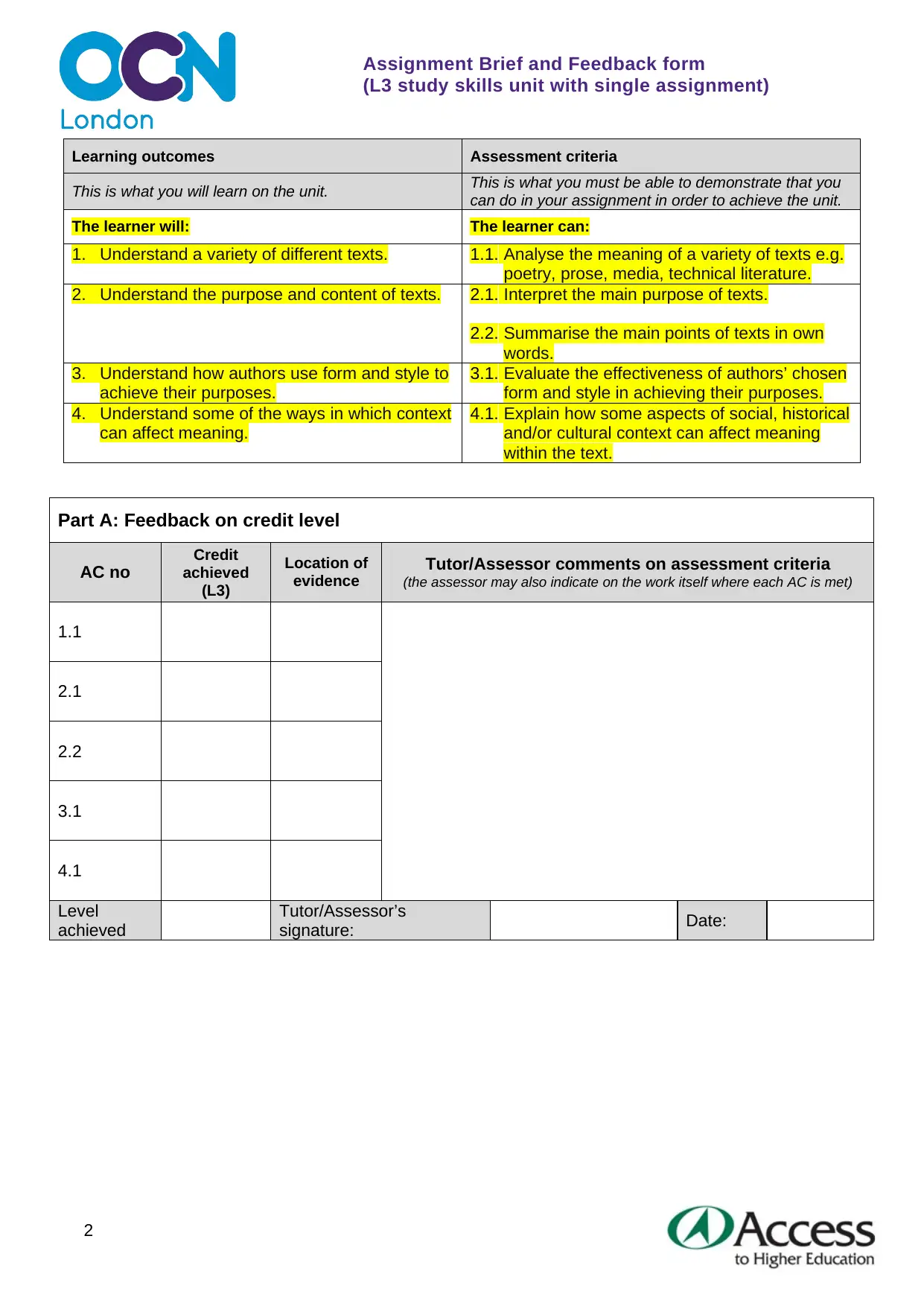
Assignment Brief and Feedback form
(L3 study skills unit with single assignment)
Learning outcomes Assessment criteria
This is what you will learn on the unit. This is what you must be able to demonstrate that you
can do in your assignment in order to achieve the unit.
The learner will: The learner can:
1. Understand a variety of different texts. 1.1. Analyse the meaning of a variety of texts e.g.
poetry, prose, media, technical literature.
2. Understand the purpose and content of texts. 2.1. Interpret the main purpose of texts.
2.2. Summarise the main points of texts in own
words.
3. Understand how authors use form and style to
achieve their purposes.
3.1. Evaluate the effectiveness of authors’ chosen
form and style in achieving their purposes.
4. Understand some of the ways in which context
can affect meaning.
4.1. Explain how some aspects of social, historical
and/or cultural context can affect meaning
within the text.
Part A: Feedback on credit level
AC no
Credit
achieved
(L3)
Location of
evidence
Tutor/Assessor comments on assessment criteria
(the assessor may also indicate on the work itself where each AC is met)
1.1
2.1
2.2
3.1
4.1
Level
achieved
Tutor/Assessor’s
signature: Date:
2
(L3 study skills unit with single assignment)
Learning outcomes Assessment criteria
This is what you will learn on the unit. This is what you must be able to demonstrate that you
can do in your assignment in order to achieve the unit.
The learner will: The learner can:
1. Understand a variety of different texts. 1.1. Analyse the meaning of a variety of texts e.g.
poetry, prose, media, technical literature.
2. Understand the purpose and content of texts. 2.1. Interpret the main purpose of texts.
2.2. Summarise the main points of texts in own
words.
3. Understand how authors use form and style to
achieve their purposes.
3.1. Evaluate the effectiveness of authors’ chosen
form and style in achieving their purposes.
4. Understand some of the ways in which context
can affect meaning.
4.1. Explain how some aspects of social, historical
and/or cultural context can affect meaning
within the text.
Part A: Feedback on credit level
AC no
Credit
achieved
(L3)
Location of
evidence
Tutor/Assessor comments on assessment criteria
(the assessor may also indicate on the work itself where each AC is met)
1.1
2.1
2.2
3.1
4.1
Level
achieved
Tutor/Assessor’s
signature: Date:
2
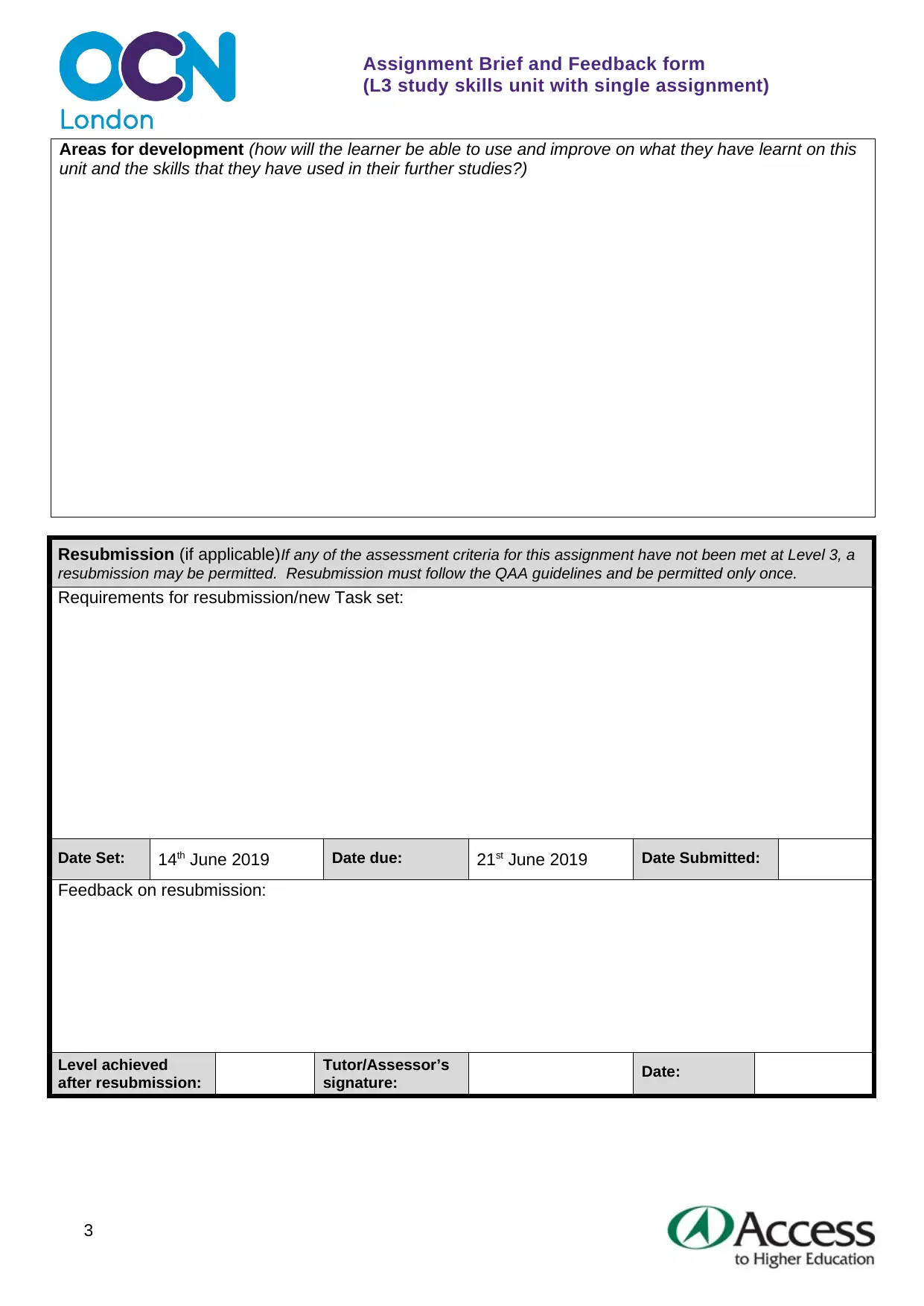
Assignment Brief and Feedback form
(L3 study skills unit with single assignment)
Areas for development (how will the learner be able to use and improve on what they have learnt on this
unit and the skills that they have used in their further studies?)
Resubmission (if applicable)If any of the assessment criteria for this assignment have not been met at Level 3, a
resubmission may be permitted. Resubmission must follow the QAA guidelines and be permitted only once.
Requirements for resubmission/new Task set:
Date Set: 14th June 2019 Date due: 21st June 2019 Date Submitted:
Feedback on resubmission:
Level achieved
after resubmission:
Tutor/Assessor’s
signature: Date:
“”
“”
3
(L3 study skills unit with single assignment)
Areas for development (how will the learner be able to use and improve on what they have learnt on this
unit and the skills that they have used in their further studies?)
Resubmission (if applicable)If any of the assessment criteria for this assignment have not been met at Level 3, a
resubmission may be permitted. Resubmission must follow the QAA guidelines and be permitted only once.
Requirements for resubmission/new Task set:
Date Set: 14th June 2019 Date due: 21st June 2019 Date Submitted:
Feedback on resubmission:
Level achieved
after resubmission:
Tutor/Assessor’s
signature: Date:
“”
“”
3
⊘ This is a preview!⊘
Do you want full access?
Subscribe today to unlock all pages.

Trusted by 1+ million students worldwide
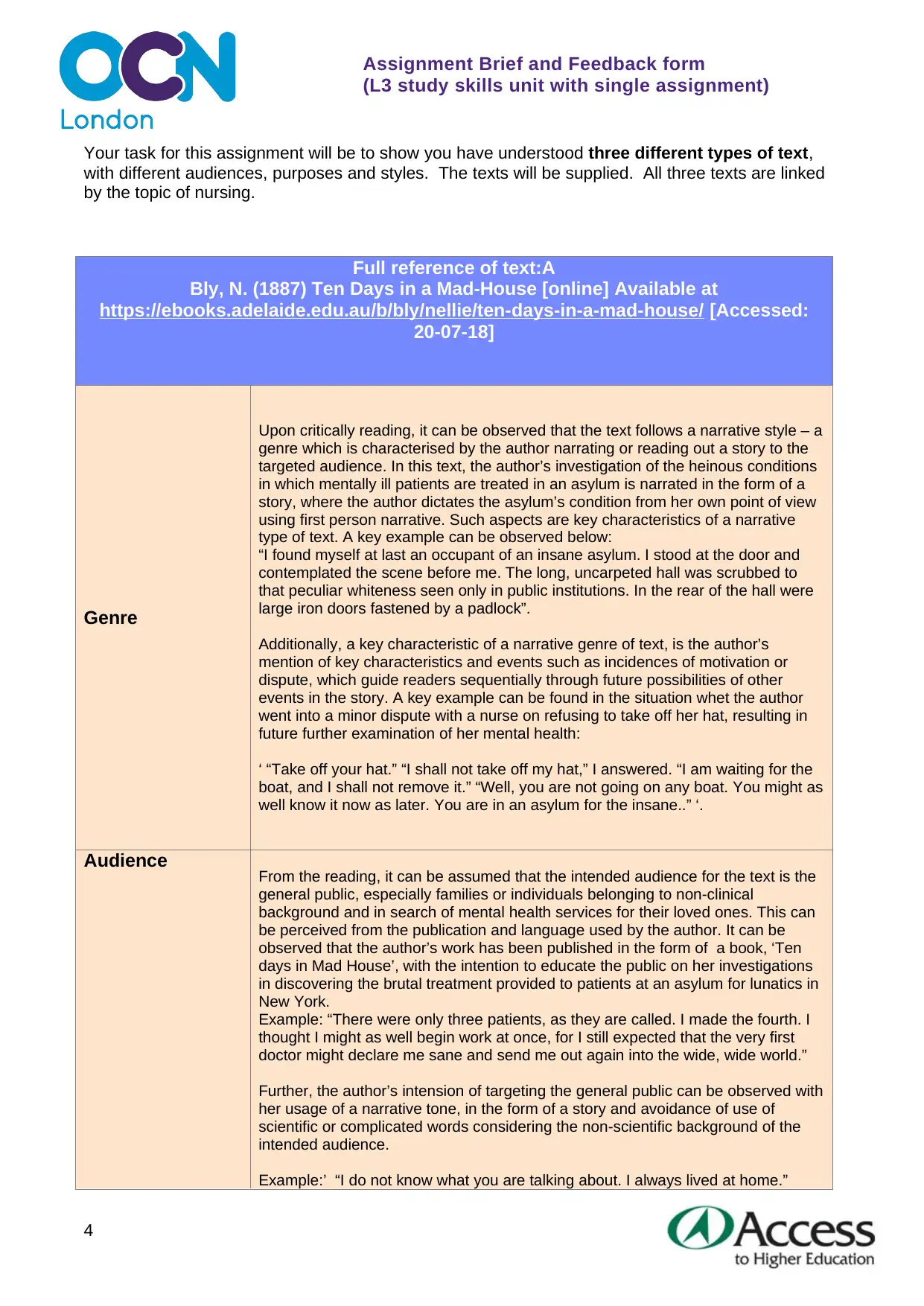
Assignment Brief and Feedback form
(L3 study skills unit with single assignment)
Your task for this assignment will be to show you have understood three different types of text,
with different audiences, purposes and styles. The texts will be supplied. All three texts are linked
by the topic of nursing.
Full reference of text:A
Bly, N. (1887) Ten Days in a Mad-House [online] Available at
https://ebooks.adelaide.edu.au/b/bly/nellie/ten-days-in-a-mad-house/ [Accessed:
20-07-18]
Genre
Upon critically reading, it can be observed that the text follows a narrative style – a
genre which is characterised by the author narrating or reading out a story to the
targeted audience. In this text, the author’s investigation of the heinous conditions
in which mentally ill patients are treated in an asylum is narrated in the form of a
story, where the author dictates the asylum’s condition from her own point of view
using first person narrative. Such aspects are key characteristics of a narrative
type of text. A key example can be observed below:
“I found myself at last an occupant of an insane asylum. I stood at the door and
contemplated the scene before me. The long, uncarpeted hall was scrubbed to
that peculiar whiteness seen only in public institutions. In the rear of the hall were
large iron doors fastened by a padlock”.
Additionally, a key characteristic of a narrative genre of text, is the author’s
mention of key characteristics and events such as incidences of motivation or
dispute, which guide readers sequentially through future possibilities of other
events in the story. A key example can be found in the situation whet the author
went into a minor dispute with a nurse on refusing to take off her hat, resulting in
future further examination of her mental health:
‘ “Take off your hat.” “I shall not take off my hat,” I answered. “I am waiting for the
boat, and I shall not remove it.” “Well, you are not going on any boat. You might as
well know it now as later. You are in an asylum for the insane..” ‘.
Audience From the reading, it can be assumed that the intended audience for the text is the
general public, especially families or individuals belonging to non-clinical
background and in search of mental health services for their loved ones. This can
be perceived from the publication and language used by the author. It can be
observed that the author’s work has been published in the form of a book, ‘Ten
days in Mad House’, with the intention to educate the public on her investigations
in discovering the brutal treatment provided to patients at an asylum for lunatics in
New York.
Example: “There were only three patients, as they are called. I made the fourth. I
thought I might as well begin work at once, for I still expected that the very first
doctor might declare me sane and send me out again into the wide, wide world.”
Further, the author’s intension of targeting the general public can be observed with
her usage of a narrative tone, in the form of a story and avoidance of use of
scientific or complicated words considering the non-scientific background of the
intended audience.
Example:’ “I do not know what you are talking about. I always lived at home.”
4
(L3 study skills unit with single assignment)
Your task for this assignment will be to show you have understood three different types of text,
with different audiences, purposes and styles. The texts will be supplied. All three texts are linked
by the topic of nursing.
Full reference of text:A
Bly, N. (1887) Ten Days in a Mad-House [online] Available at
https://ebooks.adelaide.edu.au/b/bly/nellie/ten-days-in-a-mad-house/ [Accessed:
20-07-18]
Genre
Upon critically reading, it can be observed that the text follows a narrative style – a
genre which is characterised by the author narrating or reading out a story to the
targeted audience. In this text, the author’s investigation of the heinous conditions
in which mentally ill patients are treated in an asylum is narrated in the form of a
story, where the author dictates the asylum’s condition from her own point of view
using first person narrative. Such aspects are key characteristics of a narrative
type of text. A key example can be observed below:
“I found myself at last an occupant of an insane asylum. I stood at the door and
contemplated the scene before me. The long, uncarpeted hall was scrubbed to
that peculiar whiteness seen only in public institutions. In the rear of the hall were
large iron doors fastened by a padlock”.
Additionally, a key characteristic of a narrative genre of text, is the author’s
mention of key characteristics and events such as incidences of motivation or
dispute, which guide readers sequentially through future possibilities of other
events in the story. A key example can be found in the situation whet the author
went into a minor dispute with a nurse on refusing to take off her hat, resulting in
future further examination of her mental health:
‘ “Take off your hat.” “I shall not take off my hat,” I answered. “I am waiting for the
boat, and I shall not remove it.” “Well, you are not going on any boat. You might as
well know it now as later. You are in an asylum for the insane..” ‘.
Audience From the reading, it can be assumed that the intended audience for the text is the
general public, especially families or individuals belonging to non-clinical
background and in search of mental health services for their loved ones. This can
be perceived from the publication and language used by the author. It can be
observed that the author’s work has been published in the form of a book, ‘Ten
days in Mad House’, with the intention to educate the public on her investigations
in discovering the brutal treatment provided to patients at an asylum for lunatics in
New York.
Example: “There were only three patients, as they are called. I made the fourth. I
thought I might as well begin work at once, for I still expected that the very first
doctor might declare me sane and send me out again into the wide, wide world.”
Further, the author’s intension of targeting the general public can be observed with
her usage of a narrative tone, in the form of a story and avoidance of use of
scientific or complicated words considering the non-scientific background of the
intended audience.
Example:’ “I do not know what you are talking about. I always lived at home.”
4
Paraphrase This Document
Need a fresh take? Get an instant paraphrase of this document with our AI Paraphraser
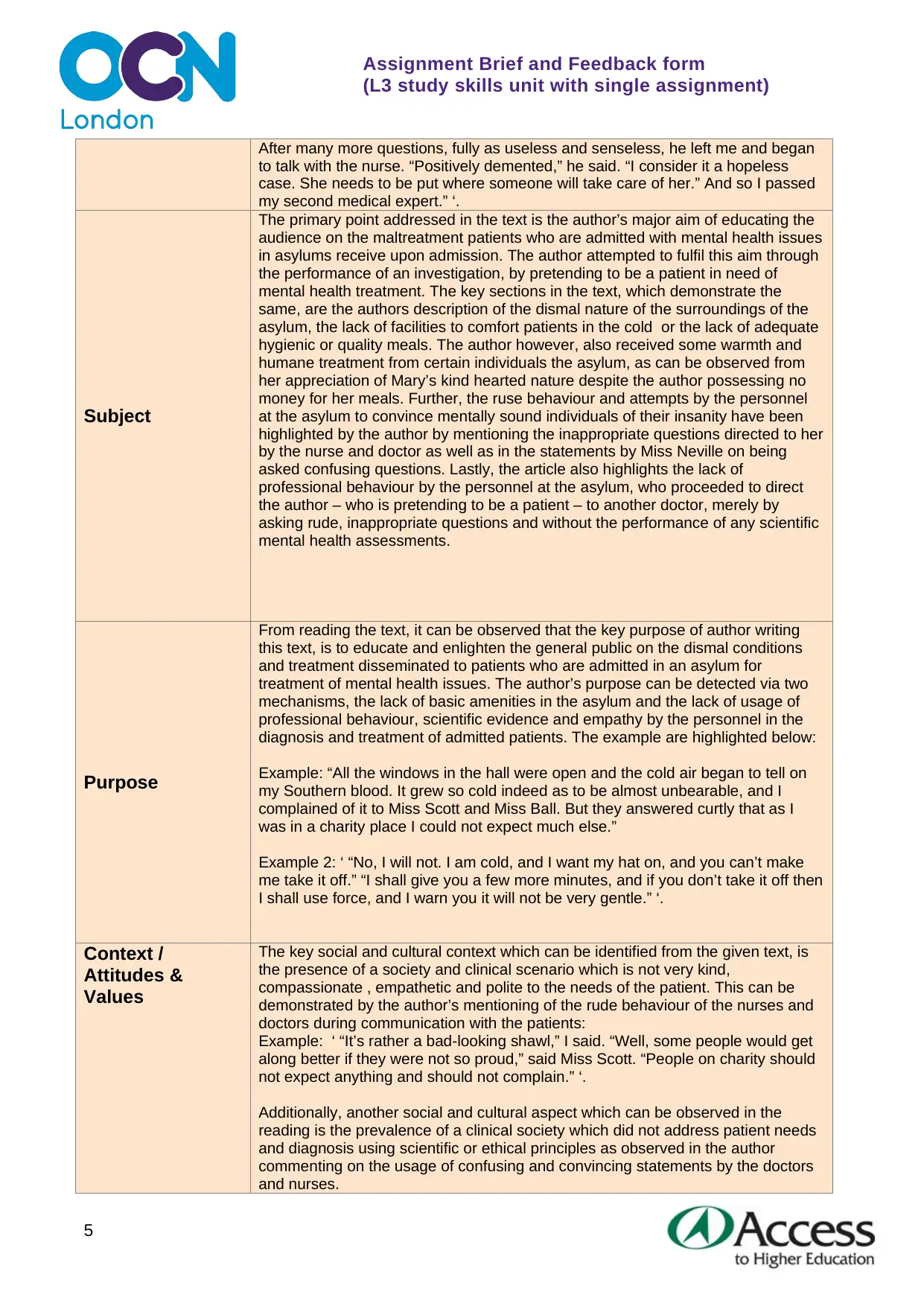
Assignment Brief and Feedback form
(L3 study skills unit with single assignment)
After many more questions, fully as useless and senseless, he left me and began
to talk with the nurse. “Positively demented,” he said. “I consider it a hopeless
case. She needs to be put where someone will take care of her.” And so I passed
my second medical expert.” ‘.
Subject
The primary point addressed in the text is the author’s major aim of educating the
audience on the maltreatment patients who are admitted with mental health issues
in asylums receive upon admission. The author attempted to fulfil this aim through
the performance of an investigation, by pretending to be a patient in need of
mental health treatment. The key sections in the text, which demonstrate the
same, are the authors description of the dismal nature of the surroundings of the
asylum, the lack of facilities to comfort patients in the cold or the lack of adequate
hygienic or quality meals. The author however, also received some warmth and
humane treatment from certain individuals the asylum, as can be observed from
her appreciation of Mary’s kind hearted nature despite the author possessing no
money for her meals. Further, the ruse behaviour and attempts by the personnel
at the asylum to convince mentally sound individuals of their insanity have been
highlighted by the author by mentioning the inappropriate questions directed to her
by the nurse and doctor as well as in the statements by Miss Neville on being
asked confusing questions. Lastly, the article also highlights the lack of
professional behaviour by the personnel at the asylum, who proceeded to direct
the author – who is pretending to be a patient – to another doctor, merely by
asking rude, inappropriate questions and without the performance of any scientific
mental health assessments.
Purpose
From reading the text, it can be observed that the key purpose of author writing
this text, is to educate and enlighten the general public on the dismal conditions
and treatment disseminated to patients who are admitted in an asylum for
treatment of mental health issues. The author’s purpose can be detected via two
mechanisms, the lack of basic amenities in the asylum and the lack of usage of
professional behaviour, scientific evidence and empathy by the personnel in the
diagnosis and treatment of admitted patients. The example are highlighted below:
Example: “All the windows in the hall were open and the cold air began to tell on
my Southern blood. It grew so cold indeed as to be almost unbearable, and I
complained of it to Miss Scott and Miss Ball. But they answered curtly that as I
was in a charity place I could not expect much else.”
Example 2: ‘ “No, I will not. I am cold, and I want my hat on, and you can’t make
me take it off.” “I shall give you a few more minutes, and if you don’t take it off then
I shall use force, and I warn you it will not be very gentle.” ‘.
Context /
Attitudes &
Values
The key social and cultural context which can be identified from the given text, is
the presence of a society and clinical scenario which is not very kind,
compassionate , empathetic and polite to the needs of the patient. This can be
demonstrated by the author’s mentioning of the rude behaviour of the nurses and
doctors during communication with the patients:
Example: ‘ “It’s rather a bad-looking shawl,” I said. “Well, some people would get
along better if they were not so proud,” said Miss Scott. “People on charity should
not expect anything and should not complain.” ‘.
Additionally, another social and cultural aspect which can be observed in the
reading is the prevalence of a clinical society which did not address patient needs
and diagnosis using scientific or ethical principles as observed in the author
commenting on the usage of confusing and convincing statements by the doctors
and nurses.
5
(L3 study skills unit with single assignment)
After many more questions, fully as useless and senseless, he left me and began
to talk with the nurse. “Positively demented,” he said. “I consider it a hopeless
case. She needs to be put where someone will take care of her.” And so I passed
my second medical expert.” ‘.
Subject
The primary point addressed in the text is the author’s major aim of educating the
audience on the maltreatment patients who are admitted with mental health issues
in asylums receive upon admission. The author attempted to fulfil this aim through
the performance of an investigation, by pretending to be a patient in need of
mental health treatment. The key sections in the text, which demonstrate the
same, are the authors description of the dismal nature of the surroundings of the
asylum, the lack of facilities to comfort patients in the cold or the lack of adequate
hygienic or quality meals. The author however, also received some warmth and
humane treatment from certain individuals the asylum, as can be observed from
her appreciation of Mary’s kind hearted nature despite the author possessing no
money for her meals. Further, the ruse behaviour and attempts by the personnel
at the asylum to convince mentally sound individuals of their insanity have been
highlighted by the author by mentioning the inappropriate questions directed to her
by the nurse and doctor as well as in the statements by Miss Neville on being
asked confusing questions. Lastly, the article also highlights the lack of
professional behaviour by the personnel at the asylum, who proceeded to direct
the author – who is pretending to be a patient – to another doctor, merely by
asking rude, inappropriate questions and without the performance of any scientific
mental health assessments.
Purpose
From reading the text, it can be observed that the key purpose of author writing
this text, is to educate and enlighten the general public on the dismal conditions
and treatment disseminated to patients who are admitted in an asylum for
treatment of mental health issues. The author’s purpose can be detected via two
mechanisms, the lack of basic amenities in the asylum and the lack of usage of
professional behaviour, scientific evidence and empathy by the personnel in the
diagnosis and treatment of admitted patients. The example are highlighted below:
Example: “All the windows in the hall were open and the cold air began to tell on
my Southern blood. It grew so cold indeed as to be almost unbearable, and I
complained of it to Miss Scott and Miss Ball. But they answered curtly that as I
was in a charity place I could not expect much else.”
Example 2: ‘ “No, I will not. I am cold, and I want my hat on, and you can’t make
me take it off.” “I shall give you a few more minutes, and if you don’t take it off then
I shall use force, and I warn you it will not be very gentle.” ‘.
Context /
Attitudes &
Values
The key social and cultural context which can be identified from the given text, is
the presence of a society and clinical scenario which is not very kind,
compassionate , empathetic and polite to the needs of the patient. This can be
demonstrated by the author’s mentioning of the rude behaviour of the nurses and
doctors during communication with the patients:
Example: ‘ “It’s rather a bad-looking shawl,” I said. “Well, some people would get
along better if they were not so proud,” said Miss Scott. “People on charity should
not expect anything and should not complain.” ‘.
Additionally, another social and cultural aspect which can be observed in the
reading is the prevalence of a clinical society which did not address patient needs
and diagnosis using scientific or ethical principles as observed in the author
commenting on the usage of confusing and convincing statements by the doctors
and nurses.
5
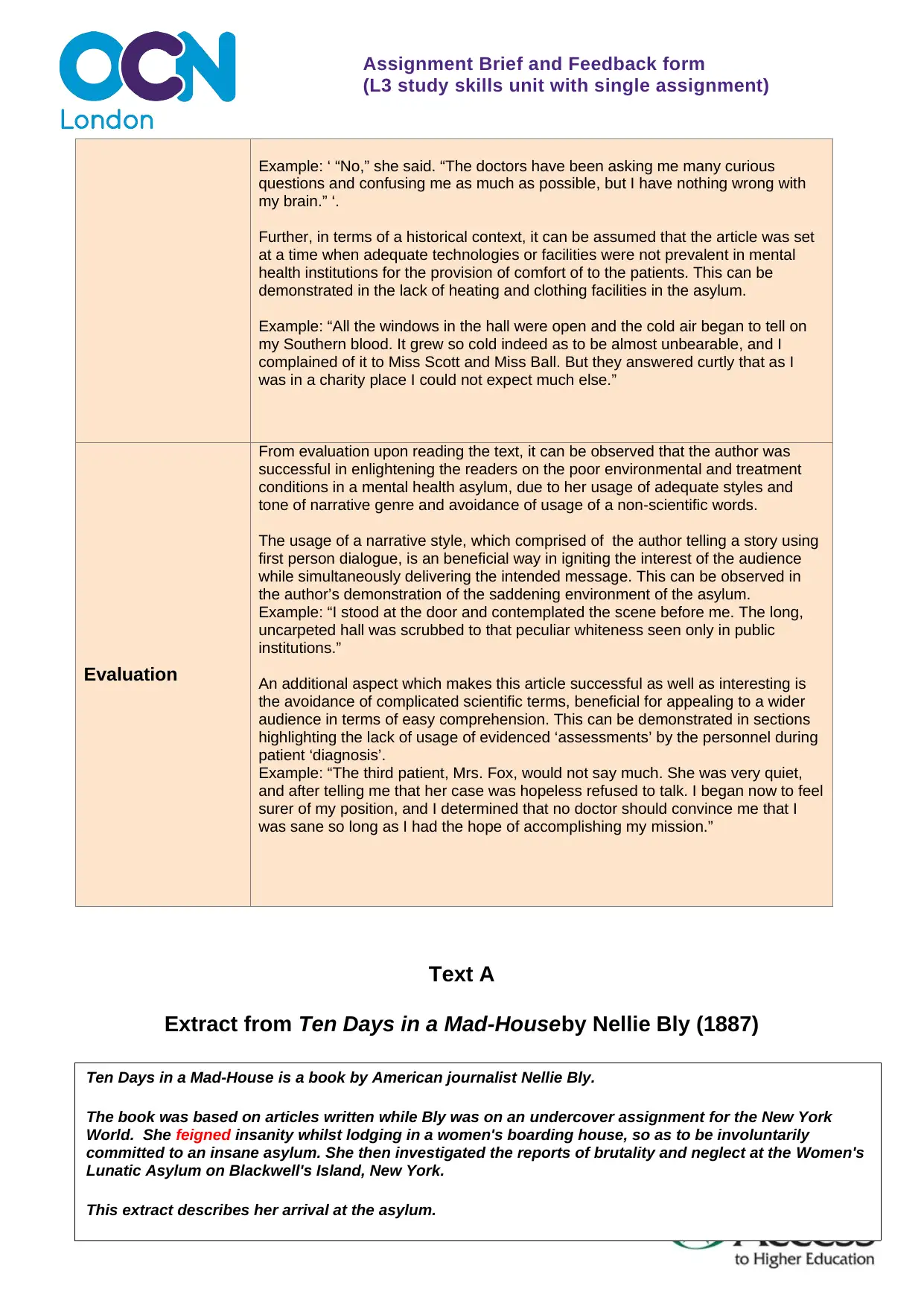
Assignment Brief and Feedback form
(L3 study skills unit with single assignment)
Example: ‘ “No,” she said. “The doctors have been asking me many curious
questions and confusing me as much as possible, but I have nothing wrong with
my brain.” ‘.
Further, in terms of a historical context, it can be assumed that the article was set
at a time when adequate technologies or facilities were not prevalent in mental
health institutions for the provision of comfort of to the patients. This can be
demonstrated in the lack of heating and clothing facilities in the asylum.
Example: “All the windows in the hall were open and the cold air began to tell on
my Southern blood. It grew so cold indeed as to be almost unbearable, and I
complained of it to Miss Scott and Miss Ball. But they answered curtly that as I
was in a charity place I could not expect much else.”
Evaluation
From evaluation upon reading the text, it can be observed that the author was
successful in enlightening the readers on the poor environmental and treatment
conditions in a mental health asylum, due to her usage of adequate styles and
tone of narrative genre and avoidance of usage of a non-scientific words.
The usage of a narrative style, which comprised of the author telling a story using
first person dialogue, is an beneficial way in igniting the interest of the audience
while simultaneously delivering the intended message. This can be observed in
the author’s demonstration of the saddening environment of the asylum.
Example: “I stood at the door and contemplated the scene before me. The long,
uncarpeted hall was scrubbed to that peculiar whiteness seen only in public
institutions.”
An additional aspect which makes this article successful as well as interesting is
the avoidance of complicated scientific terms, beneficial for appealing to a wider
audience in terms of easy comprehension. This can be demonstrated in sections
highlighting the lack of usage of evidenced ‘assessments’ by the personnel during
patient ‘diagnosis’.
Example: “The third patient, Mrs. Fox, would not say much. She was very quiet,
and after telling me that her case was hopeless refused to talk. I began now to feel
surer of my position, and I determined that no doctor should convince me that I
was sane so long as I had the hope of accomplishing my mission.”
Text A
Extract from Ten Days in a Mad-Houseby Nellie Bly (1887)
6
Ten Days in a Mad-House is a book by American journalist Nellie Bly.
The book was based on articles written while Bly was on an undercover assignment for the New York
World. She feigned insanity whilst lodging in a women's boarding house, so as to be involuntarily
committed to an insane asylum. She then investigated the reports of brutality and neglect at the Women's
Lunatic Asylum on Blackwell's Island, New York.
This extract describes her arrival at the asylum.
(L3 study skills unit with single assignment)
Example: ‘ “No,” she said. “The doctors have been asking me many curious
questions and confusing me as much as possible, but I have nothing wrong with
my brain.” ‘.
Further, in terms of a historical context, it can be assumed that the article was set
at a time when adequate technologies or facilities were not prevalent in mental
health institutions for the provision of comfort of to the patients. This can be
demonstrated in the lack of heating and clothing facilities in the asylum.
Example: “All the windows in the hall were open and the cold air began to tell on
my Southern blood. It grew so cold indeed as to be almost unbearable, and I
complained of it to Miss Scott and Miss Ball. But they answered curtly that as I
was in a charity place I could not expect much else.”
Evaluation
From evaluation upon reading the text, it can be observed that the author was
successful in enlightening the readers on the poor environmental and treatment
conditions in a mental health asylum, due to her usage of adequate styles and
tone of narrative genre and avoidance of usage of a non-scientific words.
The usage of a narrative style, which comprised of the author telling a story using
first person dialogue, is an beneficial way in igniting the interest of the audience
while simultaneously delivering the intended message. This can be observed in
the author’s demonstration of the saddening environment of the asylum.
Example: “I stood at the door and contemplated the scene before me. The long,
uncarpeted hall was scrubbed to that peculiar whiteness seen only in public
institutions.”
An additional aspect which makes this article successful as well as interesting is
the avoidance of complicated scientific terms, beneficial for appealing to a wider
audience in terms of easy comprehension. This can be demonstrated in sections
highlighting the lack of usage of evidenced ‘assessments’ by the personnel during
patient ‘diagnosis’.
Example: “The third patient, Mrs. Fox, would not say much. She was very quiet,
and after telling me that her case was hopeless refused to talk. I began now to feel
surer of my position, and I determined that no doctor should convince me that I
was sane so long as I had the hope of accomplishing my mission.”
Text A
Extract from Ten Days in a Mad-Houseby Nellie Bly (1887)
6
Ten Days in a Mad-House is a book by American journalist Nellie Bly.
The book was based on articles written while Bly was on an undercover assignment for the New York
World. She feigned insanity whilst lodging in a women's boarding house, so as to be involuntarily
committed to an insane asylum. She then investigated the reports of brutality and neglect at the Women's
Lunatic Asylum on Blackwell's Island, New York.
This extract describes her arrival at the asylum.
⊘ This is a preview!⊘
Do you want full access?
Subscribe today to unlock all pages.

Trusted by 1+ million students worldwide
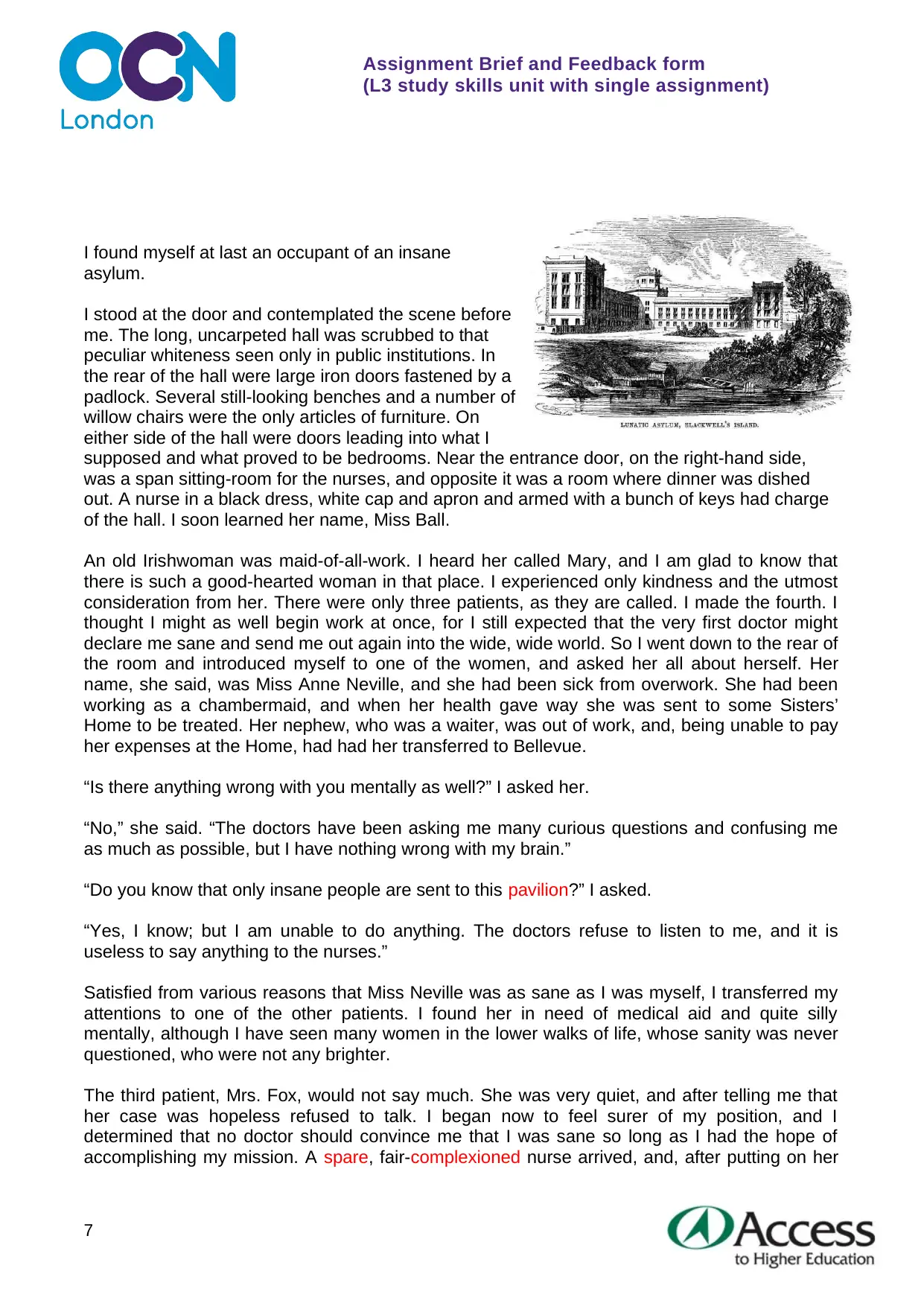
Assignment Brief and Feedback form
(L3 study skills unit with single assignment)
I found myself at last an occupant of an insane
asylum.
I stood at the door and contemplated the scene before
me. The long, uncarpeted hall was scrubbed to that
peculiar whiteness seen only in public institutions. In
the rear of the hall were large iron doors fastened by a
padlock. Several still-looking benches and a number of
willow chairs were the only articles of furniture. On
either side of the hall were doors leading into what I
supposed and what proved to be bedrooms. Near the entrance door, on the right-hand side,
was a span sitting-room for the nurses, and opposite it was a room where dinner was dished
out. A nurse in a black dress, white cap and apron and armed with a bunch of keys had charge
of the hall. I soon learned her name, Miss Ball.
An old Irishwoman was maid-of-all-work. I heard her called Mary, and I am glad to know that
there is such a good-hearted woman in that place. I experienced only kindness and the utmost
consideration from her. There were only three patients, as they are called. I made the fourth. I
thought I might as well begin work at once, for I still expected that the very first doctor might
declare me sane and send me out again into the wide, wide world. So I went down to the rear of
the room and introduced myself to one of the women, and asked her all about herself. Her
name, she said, was Miss Anne Neville, and she had been sick from overwork. She had been
working as a chambermaid, and when her health gave way she was sent to some Sisters’
Home to be treated. Her nephew, who was a waiter, was out of work, and, being unable to pay
her expenses at the Home, had had her transferred to Bellevue.
“Is there anything wrong with you mentally as well?” I asked her.
“No,” she said. “The doctors have been asking me many curious questions and confusing me
as much as possible, but I have nothing wrong with my brain.”
“Do you know that only insane people are sent to this pavilion?” I asked.
“Yes, I know; but I am unable to do anything. The doctors refuse to listen to me, and it is
useless to say anything to the nurses.”
Satisfied from various reasons that Miss Neville was as sane as I was myself, I transferred my
attentions to one of the other patients. I found her in need of medical aid and quite silly
mentally, although I have seen many women in the lower walks of life, whose sanity was never
questioned, who were not any brighter.
The third patient, Mrs. Fox, would not say much. She was very quiet, and after telling me that
her case was hopeless refused to talk. I began now to feel surer of my position, and I
determined that no doctor should convince me that I was sane so long as I had the hope of
accomplishing my mission. A spare, fair-complexioned nurse arrived, and, after putting on her
7
(L3 study skills unit with single assignment)
I found myself at last an occupant of an insane
asylum.
I stood at the door and contemplated the scene before
me. The long, uncarpeted hall was scrubbed to that
peculiar whiteness seen only in public institutions. In
the rear of the hall were large iron doors fastened by a
padlock. Several still-looking benches and a number of
willow chairs were the only articles of furniture. On
either side of the hall were doors leading into what I
supposed and what proved to be bedrooms. Near the entrance door, on the right-hand side,
was a span sitting-room for the nurses, and opposite it was a room where dinner was dished
out. A nurse in a black dress, white cap and apron and armed with a bunch of keys had charge
of the hall. I soon learned her name, Miss Ball.
An old Irishwoman was maid-of-all-work. I heard her called Mary, and I am glad to know that
there is such a good-hearted woman in that place. I experienced only kindness and the utmost
consideration from her. There were only three patients, as they are called. I made the fourth. I
thought I might as well begin work at once, for I still expected that the very first doctor might
declare me sane and send me out again into the wide, wide world. So I went down to the rear of
the room and introduced myself to one of the women, and asked her all about herself. Her
name, she said, was Miss Anne Neville, and she had been sick from overwork. She had been
working as a chambermaid, and when her health gave way she was sent to some Sisters’
Home to be treated. Her nephew, who was a waiter, was out of work, and, being unable to pay
her expenses at the Home, had had her transferred to Bellevue.
“Is there anything wrong with you mentally as well?” I asked her.
“No,” she said. “The doctors have been asking me many curious questions and confusing me
as much as possible, but I have nothing wrong with my brain.”
“Do you know that only insane people are sent to this pavilion?” I asked.
“Yes, I know; but I am unable to do anything. The doctors refuse to listen to me, and it is
useless to say anything to the nurses.”
Satisfied from various reasons that Miss Neville was as sane as I was myself, I transferred my
attentions to one of the other patients. I found her in need of medical aid and quite silly
mentally, although I have seen many women in the lower walks of life, whose sanity was never
questioned, who were not any brighter.
The third patient, Mrs. Fox, would not say much. She was very quiet, and after telling me that
her case was hopeless refused to talk. I began now to feel surer of my position, and I
determined that no doctor should convince me that I was sane so long as I had the hope of
accomplishing my mission. A spare, fair-complexioned nurse arrived, and, after putting on her
7
Paraphrase This Document
Need a fresh take? Get an instant paraphrase of this document with our AI Paraphraser
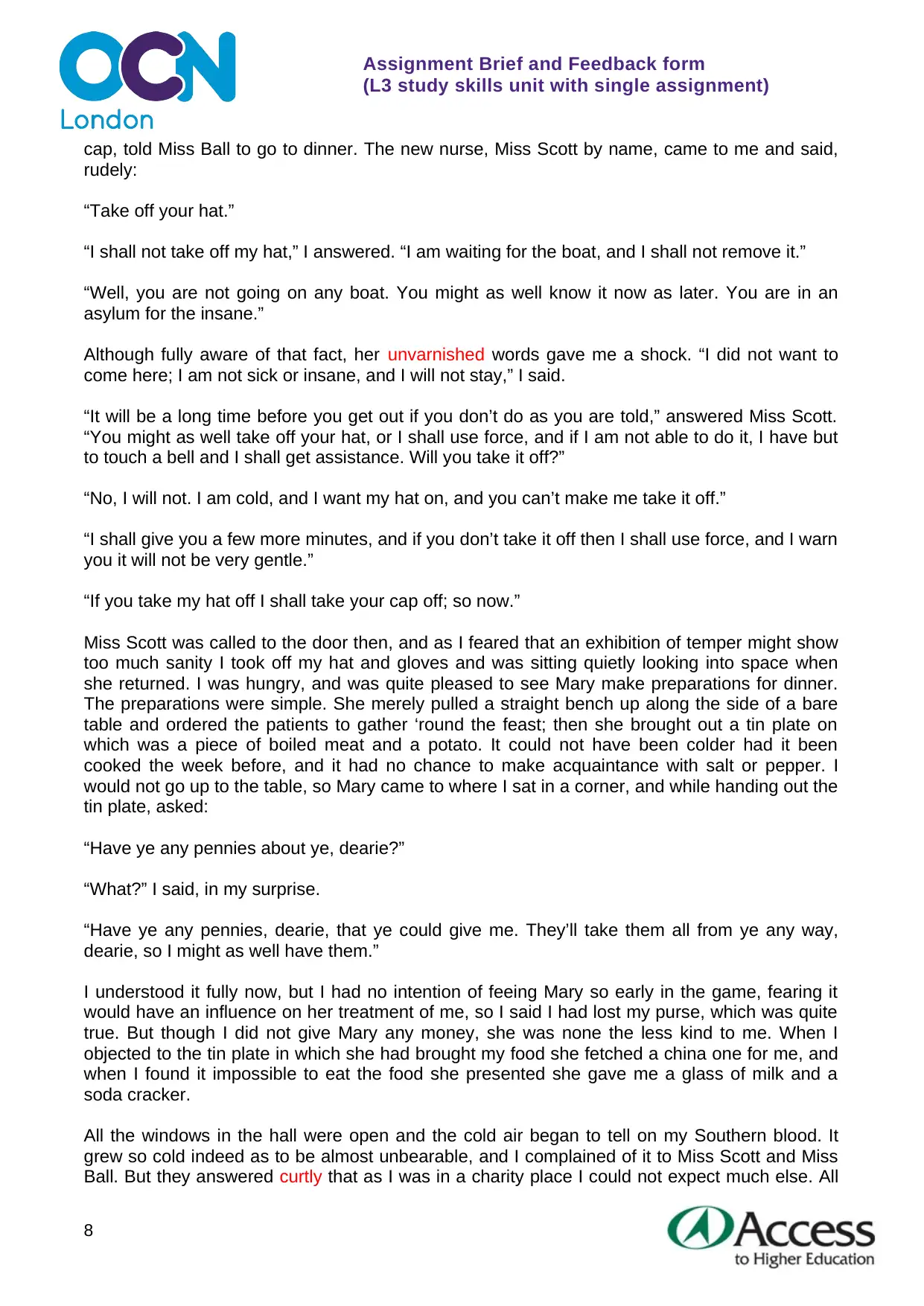
Assignment Brief and Feedback form
(L3 study skills unit with single assignment)
cap, told Miss Ball to go to dinner. The new nurse, Miss Scott by name, came to me and said,
rudely:
“Take off your hat.”
“I shall not take off my hat,” I answered. “I am waiting for the boat, and I shall not remove it.”
“Well, you are not going on any boat. You might as well know it now as later. You are in an
asylum for the insane.”
Although fully aware of that fact, her unvarnished words gave me a shock. “I did not want to
come here; I am not sick or insane, and I will not stay,” I said.
“It will be a long time before you get out if you don’t do as you are told,” answered Miss Scott.
“You might as well take off your hat, or I shall use force, and if I am not able to do it, I have but
to touch a bell and I shall get assistance. Will you take it off?”
“No, I will not. I am cold, and I want my hat on, and you can’t make me take it off.”
“I shall give you a few more minutes, and if you don’t take it off then I shall use force, and I warn
you it will not be very gentle.”
“If you take my hat off I shall take your cap off; so now.”
Miss Scott was called to the door then, and as I feared that an exhibition of temper might show
too much sanity I took off my hat and gloves and was sitting quietly looking into space when
she returned. I was hungry, and was quite pleased to see Mary make preparations for dinner.
The preparations were simple. She merely pulled a straight bench up along the side of a bare
table and ordered the patients to gather ‘round the feast; then she brought out a tin plate on
which was a piece of boiled meat and a potato. It could not have been colder had it been
cooked the week before, and it had no chance to make acquaintance with salt or pepper. I
would not go up to the table, so Mary came to where I sat in a corner, and while handing out the
tin plate, asked:
“Have ye any pennies about ye, dearie?”
“What?” I said, in my surprise.
“Have ye any pennies, dearie, that ye could give me. They’ll take them all from ye any way,
dearie, so I might as well have them.”
I understood it fully now, but I had no intention of feeing Mary so early in the game, fearing it
would have an influence on her treatment of me, so I said I had lost my purse, which was quite
true. But though I did not give Mary any money, she was none the less kind to me. When I
objected to the tin plate in which she had brought my food she fetched a china one for me, and
when I found it impossible to eat the food she presented she gave me a glass of milk and a
soda cracker.
All the windows in the hall were open and the cold air began to tell on my Southern blood. It
grew so cold indeed as to be almost unbearable, and I complained of it to Miss Scott and Miss
Ball. But they answered curtly that as I was in a charity place I could not expect much else. All
8
(L3 study skills unit with single assignment)
cap, told Miss Ball to go to dinner. The new nurse, Miss Scott by name, came to me and said,
rudely:
“Take off your hat.”
“I shall not take off my hat,” I answered. “I am waiting for the boat, and I shall not remove it.”
“Well, you are not going on any boat. You might as well know it now as later. You are in an
asylum for the insane.”
Although fully aware of that fact, her unvarnished words gave me a shock. “I did not want to
come here; I am not sick or insane, and I will not stay,” I said.
“It will be a long time before you get out if you don’t do as you are told,” answered Miss Scott.
“You might as well take off your hat, or I shall use force, and if I am not able to do it, I have but
to touch a bell and I shall get assistance. Will you take it off?”
“No, I will not. I am cold, and I want my hat on, and you can’t make me take it off.”
“I shall give you a few more minutes, and if you don’t take it off then I shall use force, and I warn
you it will not be very gentle.”
“If you take my hat off I shall take your cap off; so now.”
Miss Scott was called to the door then, and as I feared that an exhibition of temper might show
too much sanity I took off my hat and gloves and was sitting quietly looking into space when
she returned. I was hungry, and was quite pleased to see Mary make preparations for dinner.
The preparations were simple. She merely pulled a straight bench up along the side of a bare
table and ordered the patients to gather ‘round the feast; then she brought out a tin plate on
which was a piece of boiled meat and a potato. It could not have been colder had it been
cooked the week before, and it had no chance to make acquaintance with salt or pepper. I
would not go up to the table, so Mary came to where I sat in a corner, and while handing out the
tin plate, asked:
“Have ye any pennies about ye, dearie?”
“What?” I said, in my surprise.
“Have ye any pennies, dearie, that ye could give me. They’ll take them all from ye any way,
dearie, so I might as well have them.”
I understood it fully now, but I had no intention of feeing Mary so early in the game, fearing it
would have an influence on her treatment of me, so I said I had lost my purse, which was quite
true. But though I did not give Mary any money, she was none the less kind to me. When I
objected to the tin plate in which she had brought my food she fetched a china one for me, and
when I found it impossible to eat the food she presented she gave me a glass of milk and a
soda cracker.
All the windows in the hall were open and the cold air began to tell on my Southern blood. It
grew so cold indeed as to be almost unbearable, and I complained of it to Miss Scott and Miss
Ball. But they answered curtly that as I was in a charity place I could not expect much else. All
8
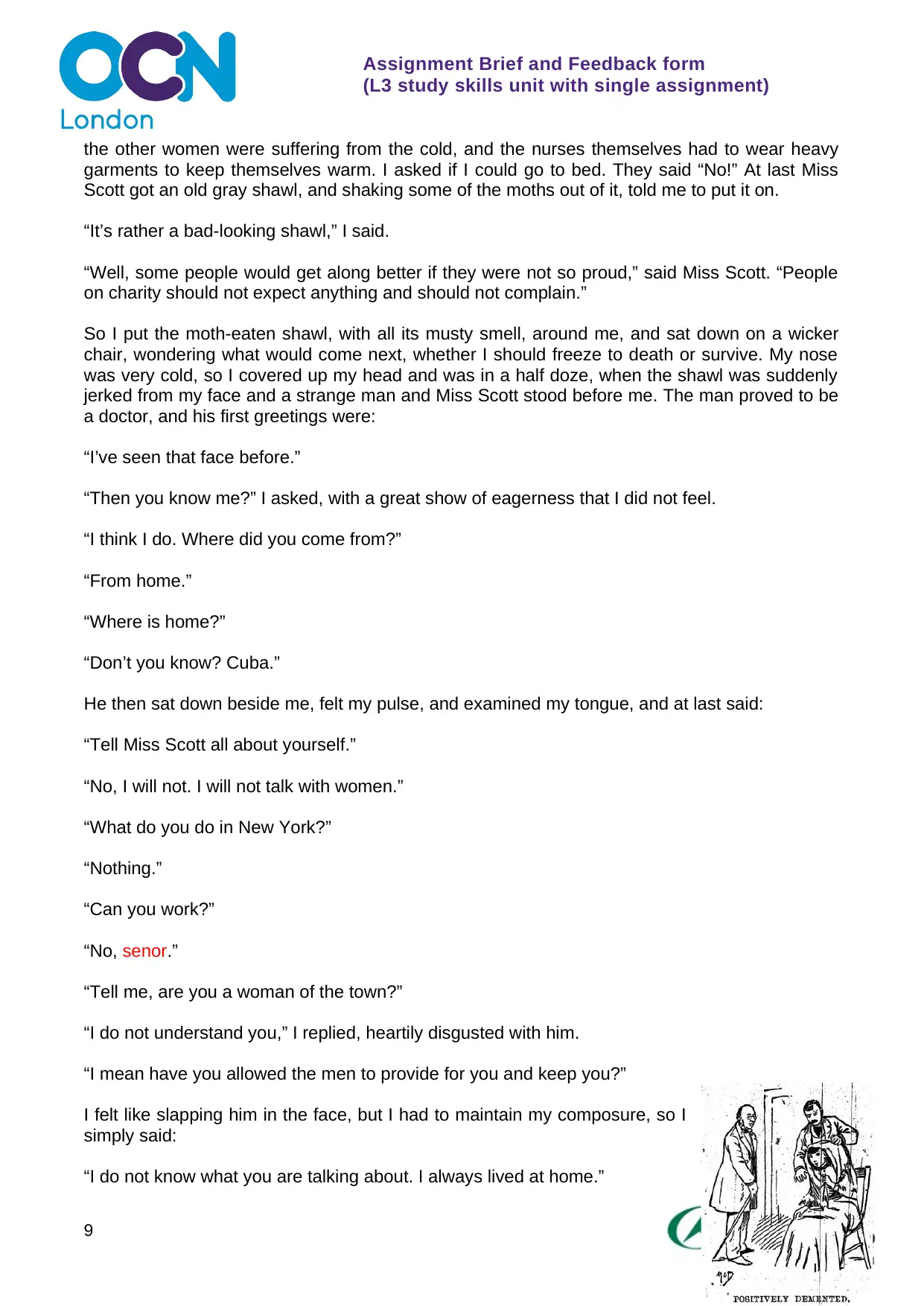
Assignment Brief and Feedback form
(L3 study skills unit with single assignment)
the other women were suffering from the cold, and the nurses themselves had to wear heavy
garments to keep themselves warm. I asked if I could go to bed. They said “No!” At last Miss
Scott got an old gray shawl, and shaking some of the moths out of it, told me to put it on.
“It’s rather a bad-looking shawl,” I said.
“Well, some people would get along better if they were not so proud,” said Miss Scott. “People
on charity should not expect anything and should not complain.”
So I put the moth-eaten shawl, with all its musty smell, around me, and sat down on a wicker
chair, wondering what would come next, whether I should freeze to death or survive. My nose
was very cold, so I covered up my head and was in a half doze, when the shawl was suddenly
jerked from my face and a strange man and Miss Scott stood before me. The man proved to be
a doctor, and his first greetings were:
“I’ve seen that face before.”
“Then you know me?” I asked, with a great show of eagerness that I did not feel.
“I think I do. Where did you come from?”
“From home.”
“Where is home?”
“Don’t you know? Cuba.”
He then sat down beside me, felt my pulse, and examined my tongue, and at last said:
“Tell Miss Scott all about yourself.”
“No, I will not. I will not talk with women.”
“What do you do in New York?”
“Nothing.”
“Can you work?”
“No, senor.”
“Tell me, are you a woman of the town?”
“I do not understand you,” I replied, heartily disgusted with him.
“I mean have you allowed the men to provide for you and keep you?”
I felt like slapping him in the face, but I had to maintain my composure, so I
simply said:
“I do not know what you are talking about. I always lived at home.”
9
(L3 study skills unit with single assignment)
the other women were suffering from the cold, and the nurses themselves had to wear heavy
garments to keep themselves warm. I asked if I could go to bed. They said “No!” At last Miss
Scott got an old gray shawl, and shaking some of the moths out of it, told me to put it on.
“It’s rather a bad-looking shawl,” I said.
“Well, some people would get along better if they were not so proud,” said Miss Scott. “People
on charity should not expect anything and should not complain.”
So I put the moth-eaten shawl, with all its musty smell, around me, and sat down on a wicker
chair, wondering what would come next, whether I should freeze to death or survive. My nose
was very cold, so I covered up my head and was in a half doze, when the shawl was suddenly
jerked from my face and a strange man and Miss Scott stood before me. The man proved to be
a doctor, and his first greetings were:
“I’ve seen that face before.”
“Then you know me?” I asked, with a great show of eagerness that I did not feel.
“I think I do. Where did you come from?”
“From home.”
“Where is home?”
“Don’t you know? Cuba.”
He then sat down beside me, felt my pulse, and examined my tongue, and at last said:
“Tell Miss Scott all about yourself.”
“No, I will not. I will not talk with women.”
“What do you do in New York?”
“Nothing.”
“Can you work?”
“No, senor.”
“Tell me, are you a woman of the town?”
“I do not understand you,” I replied, heartily disgusted with him.
“I mean have you allowed the men to provide for you and keep you?”
I felt like slapping him in the face, but I had to maintain my composure, so I
simply said:
“I do not know what you are talking about. I always lived at home.”
9
⊘ This is a preview!⊘
Do you want full access?
Subscribe today to unlock all pages.

Trusted by 1+ million students worldwide
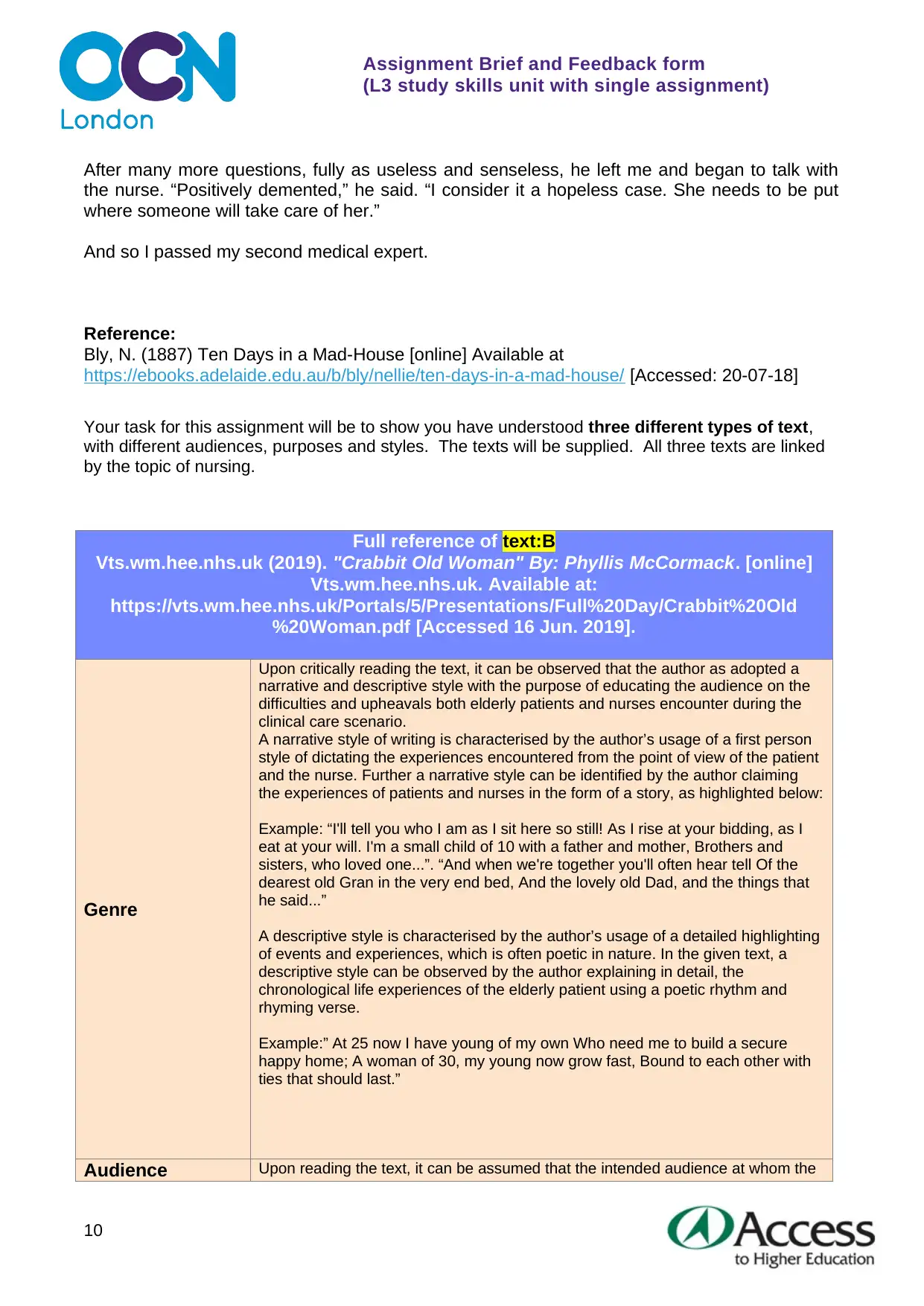
Assignment Brief and Feedback form
(L3 study skills unit with single assignment)
After many more questions, fully as useless and senseless, he left me and began to talk with
the nurse. “Positively demented,” he said. “I consider it a hopeless case. She needs to be put
where someone will take care of her.”
And so I passed my second medical expert.
Reference:
Bly, N. (1887) Ten Days in a Mad-House [online] Available at
https://ebooks.adelaide.edu.au/b/bly/nellie/ten-days-in-a-mad-house/ [Accessed: 20-07-18]
Your task for this assignment will be to show you have understood three different types of text,
with different audiences, purposes and styles. The texts will be supplied. All three texts are linked
by the topic of nursing.
Full reference of text:B
Vts.wm.hee.nhs.uk (2019). "Crabbit Old Woman" By: Phyllis McCormack. [online]
Vts.wm.hee.nhs.uk. Available at:
https://vts.wm.hee.nhs.uk/Portals/5/Presentations/Full%20Day/Crabbit%20Old
%20Woman.pdf [Accessed 16 Jun. 2019].
Genre
Upon critically reading the text, it can be observed that the author as adopted a
narrative and descriptive style with the purpose of educating the audience on the
difficulties and upheavals both elderly patients and nurses encounter during the
clinical care scenario.
A narrative style of writing is characterised by the author’s usage of a first person
style of dictating the experiences encountered from the point of view of the patient
and the nurse. Further a narrative style can be identified by the author claiming
the experiences of patients and nurses in the form of a story, as highlighted below:
Example: “I'll tell you who I am as I sit here so still! As I rise at your bidding, as I
eat at your will. I'm a small child of 10 with a father and mother, Brothers and
sisters, who loved one...”. “And when we're together you'll often hear tell Of the
dearest old Gran in the very end bed, And the lovely old Dad, and the things that
he said...”
A descriptive style is characterised by the author’s usage of a detailed highlighting
of events and experiences, which is often poetic in nature. In the given text, a
descriptive style can be observed by the author explaining in detail, the
chronological life experiences of the elderly patient using a poetic rhythm and
rhyming verse.
Example:” At 25 now I have young of my own Who need me to build a secure
happy home; A woman of 30, my young now grow fast, Bound to each other with
ties that should last.”
Audience Upon reading the text, it can be assumed that the intended audience at whom the
10
(L3 study skills unit with single assignment)
After many more questions, fully as useless and senseless, he left me and began to talk with
the nurse. “Positively demented,” he said. “I consider it a hopeless case. She needs to be put
where someone will take care of her.”
And so I passed my second medical expert.
Reference:
Bly, N. (1887) Ten Days in a Mad-House [online] Available at
https://ebooks.adelaide.edu.au/b/bly/nellie/ten-days-in-a-mad-house/ [Accessed: 20-07-18]
Your task for this assignment will be to show you have understood three different types of text,
with different audiences, purposes and styles. The texts will be supplied. All three texts are linked
by the topic of nursing.
Full reference of text:B
Vts.wm.hee.nhs.uk (2019). "Crabbit Old Woman" By: Phyllis McCormack. [online]
Vts.wm.hee.nhs.uk. Available at:
https://vts.wm.hee.nhs.uk/Portals/5/Presentations/Full%20Day/Crabbit%20Old
%20Woman.pdf [Accessed 16 Jun. 2019].
Genre
Upon critically reading the text, it can be observed that the author as adopted a
narrative and descriptive style with the purpose of educating the audience on the
difficulties and upheavals both elderly patients and nurses encounter during the
clinical care scenario.
A narrative style of writing is characterised by the author’s usage of a first person
style of dictating the experiences encountered from the point of view of the patient
and the nurse. Further a narrative style can be identified by the author claiming
the experiences of patients and nurses in the form of a story, as highlighted below:
Example: “I'll tell you who I am as I sit here so still! As I rise at your bidding, as I
eat at your will. I'm a small child of 10 with a father and mother, Brothers and
sisters, who loved one...”. “And when we're together you'll often hear tell Of the
dearest old Gran in the very end bed, And the lovely old Dad, and the things that
he said...”
A descriptive style is characterised by the author’s usage of a detailed highlighting
of events and experiences, which is often poetic in nature. In the given text, a
descriptive style can be observed by the author explaining in detail, the
chronological life experiences of the elderly patient using a poetic rhythm and
rhyming verse.
Example:” At 25 now I have young of my own Who need me to build a secure
happy home; A woman of 30, my young now grow fast, Bound to each other with
ties that should last.”
Audience Upon reading the text, it can be assumed that the intended audience at whom the
10
Paraphrase This Document
Need a fresh take? Get an instant paraphrase of this document with our AI Paraphraser
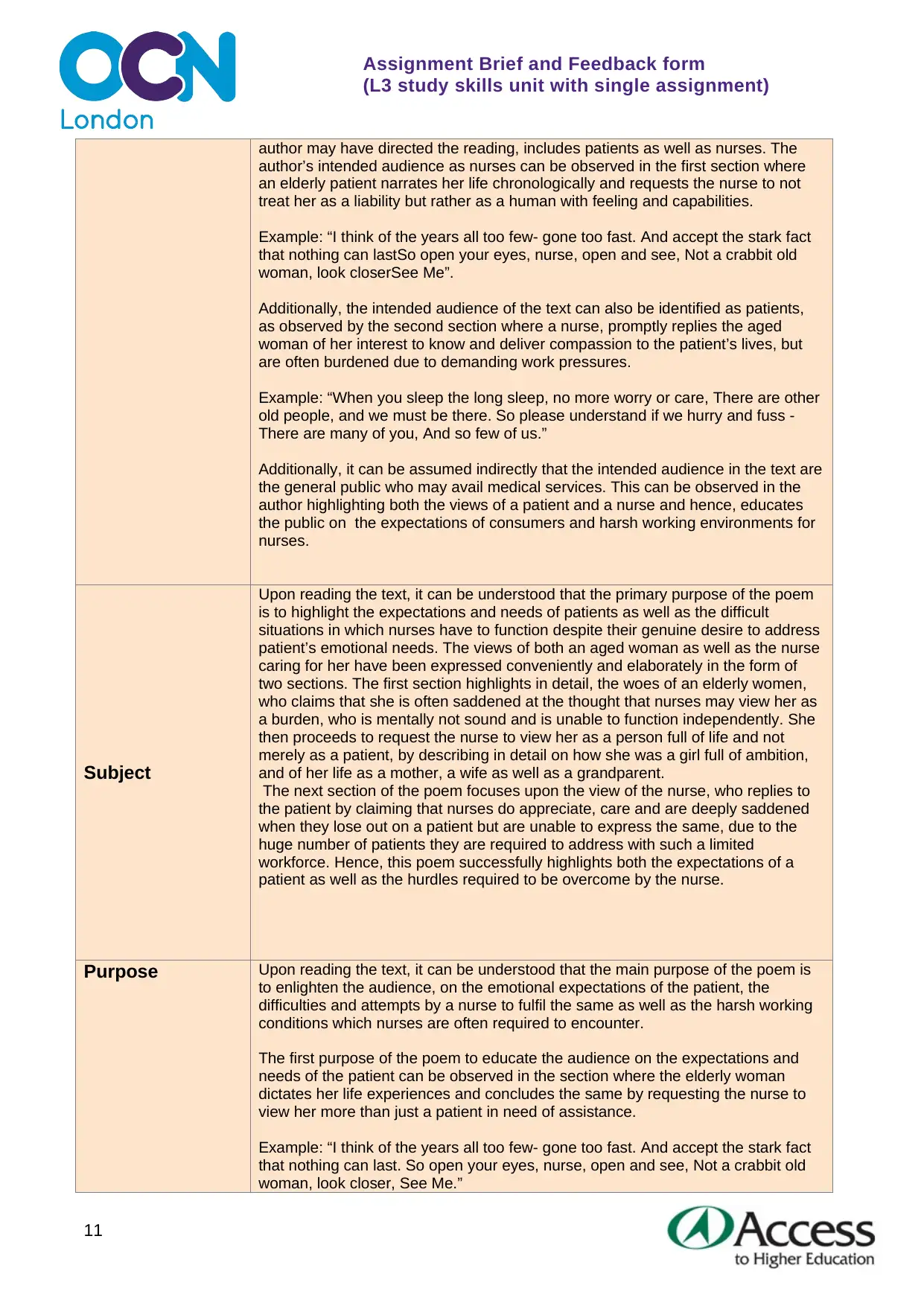
Assignment Brief and Feedback form
(L3 study skills unit with single assignment)
author may have directed the reading, includes patients as well as nurses. The
author’s intended audience as nurses can be observed in the first section where
an elderly patient narrates her life chronologically and requests the nurse to not
treat her as a liability but rather as a human with feeling and capabilities.
Example: “I think of the years all too few- gone too fast. And accept the stark fact
that nothing can lastSo open your eyes, nurse, open and see, Not a crabbit old
woman, look closerSee Me”.
Additionally, the intended audience of the text can also be identified as patients,
as observed by the second section where a nurse, promptly replies the aged
woman of her interest to know and deliver compassion to the patient’s lives, but
are often burdened due to demanding work pressures.
Example: “When you sleep the long sleep, no more worry or care, There are other
old people, and we must be there. So please understand if we hurry and fuss -
There are many of you, And so few of us.”
Additionally, it can be assumed indirectly that the intended audience in the text are
the general public who may avail medical services. This can be observed in the
author highlighting both the views of a patient and a nurse and hence, educates
the public on the expectations of consumers and harsh working environments for
nurses.
Subject
Upon reading the text, it can be understood that the primary purpose of the poem
is to highlight the expectations and needs of patients as well as the difficult
situations in which nurses have to function despite their genuine desire to address
patient’s emotional needs. The views of both an aged woman as well as the nurse
caring for her have been expressed conveniently and elaborately in the form of
two sections. The first section highlights in detail, the woes of an elderly women,
who claims that she is often saddened at the thought that nurses may view her as
a burden, who is mentally not sound and is unable to function independently. She
then proceeds to request the nurse to view her as a person full of life and not
merely as a patient, by describing in detail on how she was a girl full of ambition,
and of her life as a mother, a wife as well as a grandparent.
The next section of the poem focuses upon the view of the nurse, who replies to
the patient by claiming that nurses do appreciate, care and are deeply saddened
when they lose out on a patient but are unable to express the same, due to the
huge number of patients they are required to address with such a limited
workforce. Hence, this poem successfully highlights both the expectations of a
patient as well as the hurdles required to be overcome by the nurse.
Purpose Upon reading the text, it can be understood that the main purpose of the poem is
to enlighten the audience, on the emotional expectations of the patient, the
difficulties and attempts by a nurse to fulfil the same as well as the harsh working
conditions which nurses are often required to encounter.
The first purpose of the poem to educate the audience on the expectations and
needs of the patient can be observed in the section where the elderly woman
dictates her life experiences and concludes the same by requesting the nurse to
view her more than just a patient in need of assistance.
Example: “I think of the years all too few- gone too fast. And accept the stark fact
that nothing can last. So open your eyes, nurse, open and see, Not a crabbit old
woman, look closer, See Me.”
11
(L3 study skills unit with single assignment)
author may have directed the reading, includes patients as well as nurses. The
author’s intended audience as nurses can be observed in the first section where
an elderly patient narrates her life chronologically and requests the nurse to not
treat her as a liability but rather as a human with feeling and capabilities.
Example: “I think of the years all too few- gone too fast. And accept the stark fact
that nothing can lastSo open your eyes, nurse, open and see, Not a crabbit old
woman, look closerSee Me”.
Additionally, the intended audience of the text can also be identified as patients,
as observed by the second section where a nurse, promptly replies the aged
woman of her interest to know and deliver compassion to the patient’s lives, but
are often burdened due to demanding work pressures.
Example: “When you sleep the long sleep, no more worry or care, There are other
old people, and we must be there. So please understand if we hurry and fuss -
There are many of you, And so few of us.”
Additionally, it can be assumed indirectly that the intended audience in the text are
the general public who may avail medical services. This can be observed in the
author highlighting both the views of a patient and a nurse and hence, educates
the public on the expectations of consumers and harsh working environments for
nurses.
Subject
Upon reading the text, it can be understood that the primary purpose of the poem
is to highlight the expectations and needs of patients as well as the difficult
situations in which nurses have to function despite their genuine desire to address
patient’s emotional needs. The views of both an aged woman as well as the nurse
caring for her have been expressed conveniently and elaborately in the form of
two sections. The first section highlights in detail, the woes of an elderly women,
who claims that she is often saddened at the thought that nurses may view her as
a burden, who is mentally not sound and is unable to function independently. She
then proceeds to request the nurse to view her as a person full of life and not
merely as a patient, by describing in detail on how she was a girl full of ambition,
and of her life as a mother, a wife as well as a grandparent.
The next section of the poem focuses upon the view of the nurse, who replies to
the patient by claiming that nurses do appreciate, care and are deeply saddened
when they lose out on a patient but are unable to express the same, due to the
huge number of patients they are required to address with such a limited
workforce. Hence, this poem successfully highlights both the expectations of a
patient as well as the hurdles required to be overcome by the nurse.
Purpose Upon reading the text, it can be understood that the main purpose of the poem is
to enlighten the audience, on the emotional expectations of the patient, the
difficulties and attempts by a nurse to fulfil the same as well as the harsh working
conditions which nurses are often required to encounter.
The first purpose of the poem to educate the audience on the expectations and
needs of the patient can be observed in the section where the elderly woman
dictates her life experiences and concludes the same by requesting the nurse to
view her more than just a patient in need of assistance.
Example: “I think of the years all too few- gone too fast. And accept the stark fact
that nothing can last. So open your eyes, nurse, open and see, Not a crabbit old
woman, look closer, See Me.”
11
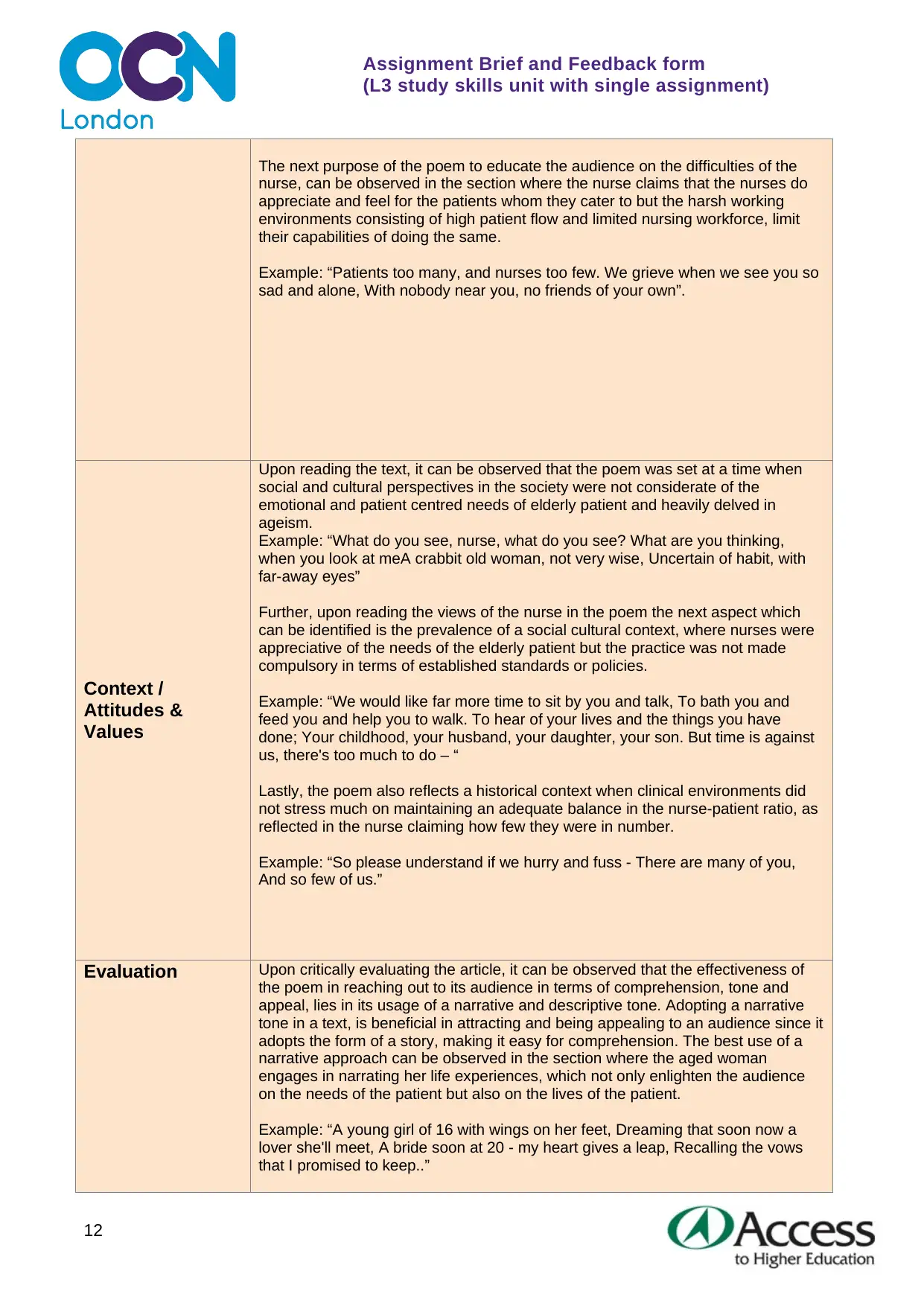
Assignment Brief and Feedback form
(L3 study skills unit with single assignment)
The next purpose of the poem to educate the audience on the difficulties of the
nurse, can be observed in the section where the nurse claims that the nurses do
appreciate and feel for the patients whom they cater to but the harsh working
environments consisting of high patient flow and limited nursing workforce, limit
their capabilities of doing the same.
Example: “Patients too many, and nurses too few. We grieve when we see you so
sad and alone, With nobody near you, no friends of your own”.
Context /
Attitudes &
Values
Upon reading the text, it can be observed that the poem was set at a time when
social and cultural perspectives in the society were not considerate of the
emotional and patient centred needs of elderly patient and heavily delved in
ageism.
Example: “What do you see, nurse, what do you see? What are you thinking,
when you look at meA crabbit old woman, not very wise, Uncertain of habit, with
far-away eyes”
Further, upon reading the views of the nurse in the poem the next aspect which
can be identified is the prevalence of a social cultural context, where nurses were
appreciative of the needs of the elderly patient but the practice was not made
compulsory in terms of established standards or policies.
Example: “We would like far more time to sit by you and talk, To bath you and
feed you and help you to walk. To hear of your lives and the things you have
done; Your childhood, your husband, your daughter, your son. But time is against
us, there's too much to do – “
Lastly, the poem also reflects a historical context when clinical environments did
not stress much on maintaining an adequate balance in the nurse-patient ratio, as
reflected in the nurse claiming how few they were in number.
Example: “So please understand if we hurry and fuss - There are many of you,
And so few of us.”
Evaluation Upon critically evaluating the article, it can be observed that the effectiveness of
the poem in reaching out to its audience in terms of comprehension, tone and
appeal, lies in its usage of a narrative and descriptive tone. Adopting a narrative
tone in a text, is beneficial in attracting and being appealing to an audience since it
adopts the form of a story, making it easy for comprehension. The best use of a
narrative approach can be observed in the section where the aged woman
engages in narrating her life experiences, which not only enlighten the audience
on the needs of the patient but also on the lives of the patient.
Example: “A young girl of 16 with wings on her feet, Dreaming that soon now a
lover she'll meet, A bride soon at 20 - my heart gives a leap, Recalling the vows
that I promised to keep..”
12
(L3 study skills unit with single assignment)
The next purpose of the poem to educate the audience on the difficulties of the
nurse, can be observed in the section where the nurse claims that the nurses do
appreciate and feel for the patients whom they cater to but the harsh working
environments consisting of high patient flow and limited nursing workforce, limit
their capabilities of doing the same.
Example: “Patients too many, and nurses too few. We grieve when we see you so
sad and alone, With nobody near you, no friends of your own”.
Context /
Attitudes &
Values
Upon reading the text, it can be observed that the poem was set at a time when
social and cultural perspectives in the society were not considerate of the
emotional and patient centred needs of elderly patient and heavily delved in
ageism.
Example: “What do you see, nurse, what do you see? What are you thinking,
when you look at meA crabbit old woman, not very wise, Uncertain of habit, with
far-away eyes”
Further, upon reading the views of the nurse in the poem the next aspect which
can be identified is the prevalence of a social cultural context, where nurses were
appreciative of the needs of the elderly patient but the practice was not made
compulsory in terms of established standards or policies.
Example: “We would like far more time to sit by you and talk, To bath you and
feed you and help you to walk. To hear of your lives and the things you have
done; Your childhood, your husband, your daughter, your son. But time is against
us, there's too much to do – “
Lastly, the poem also reflects a historical context when clinical environments did
not stress much on maintaining an adequate balance in the nurse-patient ratio, as
reflected in the nurse claiming how few they were in number.
Example: “So please understand if we hurry and fuss - There are many of you,
And so few of us.”
Evaluation Upon critically evaluating the article, it can be observed that the effectiveness of
the poem in reaching out to its audience in terms of comprehension, tone and
appeal, lies in its usage of a narrative and descriptive tone. Adopting a narrative
tone in a text, is beneficial in attracting and being appealing to an audience since it
adopts the form of a story, making it easy for comprehension. The best use of a
narrative approach can be observed in the section where the aged woman
engages in narrating her life experiences, which not only enlighten the audience
on the needs of the patient but also on the lives of the patient.
Example: “A young girl of 16 with wings on her feet, Dreaming that soon now a
lover she'll meet, A bride soon at 20 - my heart gives a leap, Recalling the vows
that I promised to keep..”
12
⊘ This is a preview!⊘
Do you want full access?
Subscribe today to unlock all pages.

Trusted by 1+ million students worldwide
1 out of 22
Related Documents
Your All-in-One AI-Powered Toolkit for Academic Success.
+13062052269
info@desklib.com
Available 24*7 on WhatsApp / Email
![[object Object]](/_next/static/media/star-bottom.7253800d.svg)
Unlock your academic potential
Copyright © 2020–2025 A2Z Services. All Rights Reserved. Developed and managed by ZUCOL.





